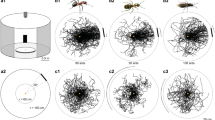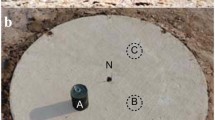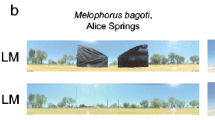Abstract
Visual cues are important navigational tools for many solitary foraging insects. In addition to information provided by path integration, desert ants learn and use visual cues for homing back to their nest. In this study, we compared the visually based learning of two desert ant species: the North African Cataglyphis fortis and the Australian Melophorus bagoti, each of which lives in ecologically similar but visually different environments. In our experiment, ants’ choice performance was measured by training foragers in a channel system. We used a decision box with two visual stimuli during their homebound trips, with one of the stimuli always being the correct one that provided thoroughfare. To determine any habitat effects on learning, we examined intraspecific comparisons in C. fortis with different nest surroundings. The intraspecific comparison in C. fortis revealed no differences in learning the task. In general, C. fortis showed little learning in our task and the results were similar for ants from barren and cluttered environments. Overall, M. bagoti learned the task faster and had a higher level of accuracy than C. fortis. One explanation for this species-specific difference could be that the cluttered habitat of M. bagoti favours the evolution of visual associative learning more so than the plain habitat of C. fortis.




Similar content being viewed by others
References
Andrews JS, Jansen JHM (1999) Matching to sample in rats using projected visual stimuli. Neurosci Res Commun 18:115–124
Bisch-Knaden S, Wehner R (2003) Landmark memories are more robust when acquired at the nest site than en route: experiments in desert ants. Naturwissenschaften 90:127–130
Bregy P, Sommer S, Wehner R (2008) Nest-mark orientation versus vector navigation in desert ants. J Exp Biol 211:1868–1873
Cheng K, Narendra A, Wehner R (2006) Behavioral ecology of odometric memories in desert ants: acquisition, retention, and integration. Behav Ecol 17:227–235
Cheng K, Narendra A, Sommer S, Wehner R (2009) Traveling in clutter: navigation in the Central Australian desert ant Melophorus bagoti. Behav Process 80:261–268
Collett TS (1992) Landmark learning and guidance. Philos Trans R Soc Biol Sci 337:295–303
Collett TS, Dillmann E, Giger A, Wehner R (1992) Visual landmarks and route following in desert ants. J Comp Physiol A 170:435–442
Dillier FX, Wehner R (2004) Spatio-temporal patterns of colony distribution in monodomous and polydomous species of North African desert ants, genus Cataglyphis. Insect Soc 51:186–196
Duelli P, Wehner R (1973) The spectral sensitivity of polarized light orientation in Cataglyphis bicolor (Formicidae, Hymenoptera). J Comp Physiol A 86:37–53
Graham P, Cheng K (2009a) Ants use the panoramic skyline as a visual cue during navigation. Curr Biol 19:935–937
Graham P, Cheng K (2009b) Which portion of the natural panorama is used for view-based navigation in the Australian desert ant? J Comp Physiol A 195:681–689
Greiner B, Narendra A, Reid SF, Zeil J (2007) Eye structure correlates with distinct foraging–bout timing in primitive ants. Curr Biol 17:879–880
Harkness R, Wehner R (1977) Cataglyphis. Endeavour 1:115–121
Heusser D, Wehner R (2002) The visual centring response in desert ants, Cataglyphis fortis. J Exp Biol 205:585–590
Johnson HM (1914) Visual pattern-discrimination in the vertebrates—II. Comparative visual acuity in the dog, the monkey and the chick. J Anim Behav 4:340–361
Knaden M, Wehner R (2005) Nest mark orientation in desert ants Cataglyphis: what does it do to the path integrator? Anim Behav 70:1349–1354
Kohler M, Wehner R (2005) Idiosyncratic route-based memories in desert ants, Melophorus bagoti: how do they interact with path-integration vectors? Neurobiol Learn Mem 83:1–12
Langdon JW, Herrnkind WF (1985) Visual shape discrimination in the fiddler crab, Uca pugilator. Mar Behav Physiol 11:315–325
Lashley KS (1912) Visual discrimination of size and form in the albino rat. J Anim Behav 2:310–331
Macquart D, Garnier L, Combe M, Beugnon G (2006) Ant navigation en route to the goal: signature routes facilitate way-finding of Gigantiops destructor. J Comp Physiol A 192:221–234
Merkle T, Wehner R (2008) Landmark cues can change the motivational state of desert ant foragers. J Comp Physiol A 194:395–403
Merkle T, Wehner R (2009) Repeated training does not improve the path integrator in desert ants. Behav Ecol Sociobiol 63:391–402
Muser B, Sommer S, Wolf H, Wehner R (2005) Foraging ecology of the thermophilic Australian desert ant, Melophorus bagoti. Aust J Zool 53:301–311
Narendra A (2007a) Homing strategies of the Australian desert ant Melophorus bagoti I. Proportional path-integration takes the ant half-way home. J Exp Biol 210:1798–1803
Narendra A (2007b) Homing strategies of the Australian desert ant Melophorus bagoti II. Interaction of the path integrator with visual cue information. J Exp Biol 210:1804–1812
Narendra A, Cheng K, Wehner R (2007) Acquiring, retaining and integrating memories of the outbound distance in the Australian desert ant Melophorus bagoti. J Exp Biol 210:570–577
Narendra A, Cheng K, Sulikowski D, Wehner R (2008) Search strategies of ants in landmark-rich habitats. J Comp Physiol A 194:929–938
Schultheiss P, Schwarz S, Wystrach A (2010) Nest relocation and colony founding in the Australian desert ant, Melophorus bagoti Lubbock (Hymenoptera: Formicidae). Psyche 2010: Article ID 435838
Sen Sarma M, Fuchs S, Tautz J (2002) Worker piping triggers hissing for coordinated colony defence in dwarf honeybee Apis florea. Zoology 105:215–223
Sherry DF, Vaccarino AL, Buckenham K, Herz RS (1989) The hippocampal complex of food-storing birds. Brain Behav Evol 34:208–317
Shettleworth SJ (1995) Comparative studies of memory in food storing birds: from the field to the Skinner box. In: Mackintosh NJ (ed) Research in naturalistic and semi-naturalistic settings. Kluwer Academic, Dordrecht, pp 159–192
Shettleworth SJ (2009) Cognition, evolution, and behavior. Oxford University Press, New York
Sommer S, Wehner R (2005) Vector navigation in desert ants, Cataglyphis fortis: celestial compass cues are essential for the proper use of distance information. Naturwissenschaften 92:468–471
Sommer S, von Beeren C, Wehner R (2008) Multiroute memories in desert ants. Proc Natl Acad Sci USA 105:317–322
Srinivasan MV, Zhang SW, Witney K (1994) Visual discrimination of pattern orientation by honeybees: performance and implications for ‘cortical’ processing. Philos Trans R Soc Biol Sci 343:199–210
Steck K, Hansson BS, Knaden M (2009) Smells like home: desert ants, Cataglyphis fortis, use olfactory landmarks to pinpoint the nest. Front Zool 6:5
Sutherland NS (1958) Visual discrimination of the orientation of rectangles by Octopus vulgaris Lamarck. J Comp Physiol Psych 51:452–458
von Frisch K (1914) Der Farbensinn und Formensinn der Biene. Fischer Verlag, Jena
Vowles DM (1950) Sensitivity of ants to polarized light. Nature 165:282–283
Wäckers FL, Lewis WJ (1999) A comparison of color-, shape- and pattern- learning by the hymenopteran parasitoid Microplitis croceipes. J Comp Physiol A 184:387–393
Wehner R (1987) Spatial organization of foraging behavior in individually searching desert ants, Cataglyphis (Sahara Desert) and Ocymyrmex (Namib Desert). In: Pasteels JM, Deneubourg JL (eds) From individual to collective behavior in social insects. Birkhäuser, Basel, pp 15–42
Wehner R (2003) Desert ant navigation: how miniature brains solve complex tasks. J Comp Physiol A 189:579–588
Wehner R, Räber F (1979) Visual spatial memory in desert ants, Cataglyphis bicolor (Hymenoptera: Formicidae). Experientia 35:579–588
Wehner R, Müller M (2006) The significance of direct sunlight and polarized skylight in the ant’s celestial system of navigation. Proc Natl Acad Sci USA 103:1275–1279
Wehner R, Fukushi T, Isler K (2007) On being small: brain allometry in ants. Brain Behav Evol 69:220–228
Wright AA, Cook RG, Rivera JJ, Sands SF (1988) Concept learning by pigeons: matching-to-sample with trial-unique video picture stimuli. Anim Learn Behav 16:436–444
Zeigler HP, Schmerler S (1965) Visual discrimination of orientation by pigeons. Anim Behav 13:475–477
Zhang SW, Schwarz S, Pahl M, Zhu H, Tautz J (2006) Honeybee memory: a honeybee knows what to do and when. J Exp Biol 209:4420–4428
Acknowledgement
The research reported here was supported by funds from Macquarie University and from the Australian Research Council (DP0770300 to K Cheng and R Wehner). We are grateful for the facilities provided by CSIRO Centre for Arid Zone Research, Alice Springs, Australia. We highly appreciate the help and support of Kathrin Steck and Markus Knaden in Maharès, Tunisia. We also thank Paul Graham, Patrick Schultheiss, Antoine Wystrach and two anonymous referees for constructive suggestions on the manuscript. SS was supported by a graduate scholarship from Macquarie University.
Author information
Authors and Affiliations
Corresponding author
Additional information
Communicated by M. Beekman
Rights and permissions
About this article
Cite this article
Schwarz, S., Cheng, K. Visual associative learning in two desert ant species. Behav Ecol Sociobiol 64, 2033–2041 (2010). https://doi.org/10.1007/s00265-010-1016-y
Received:
Revised:
Accepted:
Published:
Issue Date:
DOI: https://doi.org/10.1007/s00265-010-1016-y




